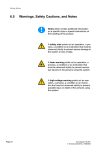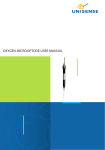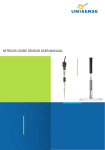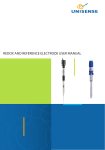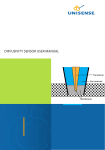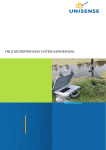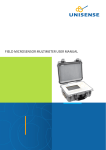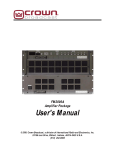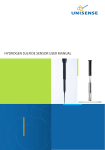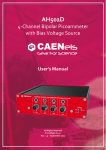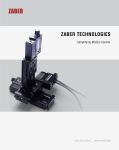Download FLOW SENSOR USER MANUAL
Transcript
FLOW SENSOR USER MANUAL 1 FLOW SENSOR MANUAL UNISENSE A/S Flow sensor manual Copyright © 2012· Unisense A/S Version April 2012 TABLE OF CONTENTS CONGRATULATIONS WITH YOUR NEW PRODUCT! . . . . . . . . . . . . . . . . . . . . . . . . . . . . 1 Support, ordering, and contact information 1 OVERVIEW . . . . . . . . . . . . . . . . . . . . . . . . . . . . . . . . . . . . . . . . . . . . . . . . . . . . . . . . . . . . . . . . . . . . 3 PRECAUTIONS . . . . . . . . . . . . . . . . . . . . . . . . . . . . . . . . . . . . . . . . . . . . . . . . . . . . . . . . . . . . . . . . 4 GETTING STARTED . . . . . . . . . . . . . . . . . . . . . . . . . . . . . . . . . . . . . . . . . . . . . . . . . . . . . . . . . . . 5 Unpacking a new sensor Polarization Connecting the microsensor Pre-polarization Supply tracer Calibration 5 5 5 5 6 7 GENERAL USE OF THE FLOW SENSOR . . . . . . . . . . . . . . . . . . . . . . . . . . . . . . . . . . . . . . . . . 9 Mounting of the sensors Electrical noise Interference 9 9 9 ADVANCED USE OF THE FLOW SENSORS . . . . . . . . . . . . . . . . . . . . . . . . . . . . . . . . . . . . . 10 STORAGE AND MAINTENANCE . . . . . . . . . . . . . . . . . . . . . . . . . . . . . . . . . . . . . . . . . . . . . . 11 REFERENCES . . . . . . . . . . . . . . . . . . . . . . . . . . . . . . . . . . . . . . . . . . . . . . . . . . . . . . . . . . . . . . . . . 12 WARRANTY AND LIABILITY . . . . . . . . . . . . . . . . . . . . . . . . . . . . . . . . . . . . . . . . . . . . . . . . . . 13 Repair or adjustment 13 TROUBLE SHOOTING . . . . . . . . . . . . . . . . . . . . . . . . . . . . . . . . . . . . . . . . . . . . . . . . . . . . . . . . 14 CONGRATULATIONS WITH YOUR NEW PRODUCT! Support, ordering, and contact information If you wish to order additional products or if you encounter any problems and need scientific/technical assistance, please do not hesitate to contact our sales and support team. We will respond to your inquiry within one working day. E-mail: [email protected] Unisense A/S Tueager 1 DK-8200 Aarhus N, Denmark Tel: +45 8944 9500 Fax: +45 8944 9549 Further documentation and support is available at our website www.unisense.com. REPLACEMENT OF SENSORS Unisense will replace sensors that have been damaged during shipment provided that: • The sensors were tested immediately upon receipt in accordance with the delivery note and the manual • The seal is still intact. • The sensors are returned to Unisense for inspection within two weeks. • The sensors are correctly packed for return to Unisense, in accordance with the note included in the sensor box. 1 RECOMMENDED AMPLIFIERS One-channel amplifier: Microsensor Monometer Multi-channel amplifier: Microsensor Multimeter 2 OVERVIEW The Unisense flow microsensor is based on a unique principle, which allows fluid velocity measurements to be performed at the very tip of a sensor with a tip diameter of 10-50 microns. The sensor is applicable within several areas of research, e.g. physiology, hydrology, biotechnology, and environmental sciences WARNING Unisense sensors are neither intended nor approved for use on humans With its minute tip size the Unisense flow microsensor makes it possible to make reliable and fast fluid velocity measurements with a high spatial resolution. Tracer reservoir capillaries LEMO plug Sensor tip THIS MANUAL COVERS THE UNISENSE SENSORS FS20 (outer tip diameter 20-30µm) FS-spec - Flow sensors with customer specified specifications. Cable includes guard The Unisense flow microsensor is a based on a miniaturized amperometric hydrogen micro-transducer surrounded by a tracer gas reservoir, which is closed by a tip membrane. The hydrogen tracer gas will diffuse out of the tracer reservoir and result in a build-up of hydrogen around the sensor tip. If the medium is stagnant, the hydrogen tracer will build up to a relatively high steady-state concentration. The faster the medium moves relative to the sensor tip, transporting tracer molecules away from the sensor tip, the lower the resulting hydrogen concentration at the tip. The hydrogen tracer concentration level is detected by the micro-transducer, and the signal size from the micro-transducer can thus be correlated with the velocity of the medium. The flow microsensor must be connected to a picoammeter (e.g. the Unisense Microsensor Multimeter or Microsensor Monometer). 3 PRECAUTIONS Particles at the sensor tip The signal is very sensitive to particles adhering to the tip. Even small dust grains attached to the tip will create a significant signal increase due to the associated stagnant water. For this reason it is recommended that a fine brush is implemented into the measuring setup, so the sensor tip can be cleaned at regular intervals. Direction of flow The flow sensors are always somewhat directionally sensitive. This is because it is impossible to build the sensor completely symmetrically. Thus, you either need to know the direction of flow in your system and calibrate in the same direction, or you operate with substantial uncertainties, especially at high velocities. Calibration of flow sensor You need a dedicated calibration setup preferable consisting of a system with stagnant water, which can be moved at well-defined speeds. Contact Unisense about details and support on this issue. Hydrogen supply A source of hydrogen gas must be available for a continuous flushing of the tracer reservoir (gas consumption approx. 5 ml/ minute). Alternatively, the sensors can be made with a refillable but closed reservoir for measurements where a source of hydrogen gas is not available. However, the signal will decrease at a rate of typically 10%/day due to inevitable leakage, necessitating re-calibration at regular intervals. Temperature Like al other sensors, the flow sensor is temperature sensitive. 4 GETTING STARTED The signal from the flow sensor is generated in pA. Therefore the sensor must be connected to a picoampere amplifier, like the Unisense Microsensor Multimeter. Unpacking a new sensor When receiving a new microsensor, remove the shock-absorbing grey plastic net. Please do not remove the seal and protective tube before the following steps are successfully completed. WARNING Do not remove seal and protective plastic tube before the following steps are successfully completed. Polarization The signal from the flow sensor is generated in picoampere. Therefore the sensor must be connected to a polarizing picoammeter (e.g. a Microsensor Monometer, a Microsensor Multimeter, or the Unisense PA2000). Flow sensors should be polarized at +1000 mV. The polarization voltage is set in the amplifier. For details on how to set and check the polarization, consult the user manual of the picoammeter to be used. If you are using a PA2000 amplifier, please check the polarization voltage before connecting the sensor, since incorrect polarization may destroy the sensor. Connecting the microsensor Connect the LEMO connector to the input terminal. The LEMO connector contains connections for both reference, guard, and sensing cathode. Pre-polarization When the sensor is not in use, H2 will build up inside the electrolyte of the hydrogen transducer. This must be removed in order to obtain a stable zero current as background for calibrations and measurements. Therefore, a period of polarization is necessary 5 before you can use the sensor. This is called the pre-polarization period. Just after connecting the sensor, the signal will be very high and then drop rapidly over the first few minutes. After that the signal will drop slowly for up to 1 hour. If the sensor is new or has not been operated for several days, it must be polarized for at least 1 hour before it can be calibrated and used. After shorter periods without polarization, the sensor should be polarized until it has exhibited a stable signal for 10 minutes. The signal depends on the specific sensor (see the value in the specifications that came with the sensor). If the signal does not stabilize or is too high or too low, refer to the ‘Trouble-shooting’ section of this manual. Supply tracer If your flow microsensor is of the flow-through type, connect a tracer source to one of the steel capillaries. The tracer source is a tank of suitable tracer gas with an outlet valve, which leads the tracer through a soft tube. By inserting a T-piece with a side-tube, opening at the bottom of a beaker of water, a suitable pressure can be obtained. Adjust the outlet flow from the tracer tank to a level just under the point when bubbles appear from the side-tube. It is generally best to minimize the length of the tubes used in the set-up. If the sensor is of the closed reservoir type with a refill system, start by refilling the reservoir if necessary. The refill system consists of two glass tube inlets with a silicone septum and sealed with wax, which closes the two steel capillaries of the tracer reservoir. To refill the reservoir, proceed as follows: Insert a 0.5-mm syringe needle, through both wax plugs proceeding slightly into the silicone membrane. After piercing the wax plugs a fresh 0.5-mm syringe needle is carefully inserted through the hole of each wax plug and pushed through the silicone membrane. A dry 20-ml syringe is filled with the desired tracer (e.g. 100% hydrogen) from a tracer source. The tracer must be dry. The syringe is attached to the needle in one of the inlets. Atmospheric contamination of the tracer in the syringe during transfer can be avoided by keeping the nozzle blocked 6 when possible, or by releasing a small tracer flow through the nozzle when it is not blocked. When the syringe is attached to the needle, the tracer is slowly injected. Make sure that the reservoir is actually flushed. This is achieved when a tracer stream flows from the needle in the other inlet. This can be detected by feeling the gas stream against the eye or by observing bubbles when a soap-covered finger is held lightly against the top of the needle. Be careful not to introduce moisture into the reservoir! When the reservoir has been flushed with at least 10 ml of the tracer, remove the syringe and the attached needle. Wait 3 seconds, then remove the needle in the other inlet. The silicone membrane will now keep the tracer inside the reservoir, but to make the final gas-tight seal, the wax plugs must be re-melted. This is done by heating a metal object (e.g. the tips of a pair of tweezers) and holding it against the outside of the glass inlet, just long enough for the wax to become clear and liquid. When the wax hardens, the refill is completed. When the tracer is present in the reservoir, the signal should decrease when the water, in which the sensor tip is immersed, is moved by gently moving the beaker up and down. If the sensor responds consistently in this fashion, it is functioning correctly. Calibration Calibration must be performed after the signal has stabilized during pre-polarization. Please consult the software manual for instruction on how to calibrate in the software. The flow microsensor is placed in a calibration set-up. Such a set-up consists of a device that allows the sensor tip to be immersed in a liquid medium, which can be moved at controlled linear velocities. Alternatively, the sensor tip is moved at controlled velocities through a stationary medium. The set-up is activated through a range of known velocities, and when it has stabilized the signal is logged at each velocity. The readings are used to produce a calibration curve, through which a measured signal can be converted into a velocity. IMPORTANT: small dust particles may adhere to the flow microsensor tip and strongly influence the signal. If this happens, IMPORTANT It is necessary to perform calibration and subsequent measurements in solutions with the same temperature and salinity. IMPORTANT Flow microsensors are not completely symmetrical, which means that there is some directional sensitivity. Always calibrate with the sensor oriented in the same way relative to the direction of flow as in the system to be studied 7 remove the particles by carefully brushing the tip with a very fine paintbrush (the finest type that can be bought for art painting). The brush is preferably mounted under water with its hairs pointing up; the sensor tip is cleaned by moving it back and forth with the micromanipulator controls through the tips of the brush hairs. If you touch the tip with coarser parts of the brush, the sensor may break. Check and repeat calibration at appropriate intervals to ensure that all measurements can be calibrated to correct velocities. To minimize the need for calibrations, keep the sensor polarized between measurements, unless the time between measurements exceeds several days The gas permeability of flow microsensor membranes changes with time, so a change in signal of up to 50% may occur over months. If the sensor functions according to the above procedure, the seal and protective plastic tube can be carefully removed before making measurements. 8 GENERAL USE OF THE FLOW SENSOR Flow sensors can be used for a wide variety of measurements (see www.unisense.com for further information) but they are most commonly used for monitoring flow in boundary layers between water and the sea floor, leaves, stones etc. Often they are used in systems where a high spatial resolution is required or for flow measurements in water samples. Mounting of the sensors During measurements the sensor should be properly mounted in a stable set-up. Due to the small size of the microsensor tip and the steepness of flow gradients in many environments, even a few microns’ displacement of the sensor tip may change its immediate flow environment. Furthermore, lateral movements of the sensor while it is in contact with solid substrate may harm the sensor. Therefore measurements should be performed only in a stabilized set-up fixed on a sturdy table, free of moving or vibrating devices. We recommend the Unisense Laboratory Stand LS18 and the Unisense micromanipulators for this purpose. IMPORTANT When the sensor tip is in contact with a solid substrate, do not make lateral movements of the microsensor and avoid disturbing the microsensor equipment or table. Electrical noise The signal of the microsensor is very small (10-13 to 10-10 amp.). Although both the amplifiers and the microsensors are very resistant to electrical noise from the environment, electrical fields may interfere with the sensor signal. Therefore we recommend that unnecessary electrical/mechanical equipment is switched off and the sensor or wires are not touched during measurements and signal recording. Interference The presence of sulphide gas can seriously affect measurements. The sensitivity to sulfide gas can be as much as 10% of the hydrogen sensitivity. In addition, exposure to high sulfide gas concentration can affect the calibration of the hydrogen sensor. Therefore measurements done in environments with high sulfide concentrations are not recommended. IMPORTANT Closely monitor the temperature, as the sensor signal is very dependent on temperature. The temperature coefficient varies from sensor to sensor but is approximately 2-3 % per oC. 9 ADVANCED USE OF THE FLOW SENSORS Unisense can construct flow sensors for customer requested applications at additional costs. The most frequently requested construction options are described at our web page under flow sensors specifications. The options include e.g. customer specified dimensions, response time, stirring sensitivity, pressure tolerance, flow range and detection limit. If your specifications for a special flow sensor are not described at our web page please contact [email protected] for further options and prices. Examples of advanced applications • Measurements of blood flow • Monitoring bioturbation by measurements of flow in worm tubes (contact sales@unisense. com for further details) 10 STORAGE AND MAINTENANCE Store the sensor in the protective plastic tube used for shipping. The hydrogen microsensor can be stored with the tip exposed to water or air. The room in which the hydrogen microsensor is stored should be dry and not too hot (10-30oC). If the sensor is used regularly it can be stored polarized and connected to the amplifier. 11 REFERENCES • Revsbech, N. P., and B. B. Jørgens. 1986. Micorelectrodes: Their Use in Microbial Ecology, p. 293-352. In K. C. Marshall (ed.), Advances in Microbial Ecology, vol. 9. Plenum, New York. • Kühl M. Revsbech, NP. 2001 Biogeochemical microsensors for boundary layer studies. In: Boudreau BP, Jørgensen BB, editors. The Benethic boundary layer. New York: Oxford University press. p180-210. 12 WARRANTY AND LIABILITY Microsensors are consumable items. The sensors are tested thoroughly before packaging and shipment. Warranty for sensors: N2O sensors: 60 days from shipment. Standard Oxygen sensors: 180 days from shipment. All other sensors excluding special sensors: 90 days from shipment. If, within the above specified period, the sensor(s) fail to perform according to the specifications, Unisense will replace the sensor(s) free of charge. Unisense will only replace dysfunctional sensors if they have been tested according with the instructions in the manual upon receipt of the sensor(s).The warranty does not include repair or replacement necessitated by accident, neglect, misuse, unauthorized repair, or modification of the product. Physical damage to the tip of the sensor is not covered by the warranty. Liability In no event will Unisense be liable for any direct, indirect, consequential or incidental damages, including lost profits, or for any claim by any third party, arising out of the use, the results of use, or the inability to use this product. Repair or adjustment Sensors and electrodes cannot be repaired. Other equipment that is not covered by the warranty will, if possible, be repaired by Unisense with appropriate charges paid by the customer. In case of return of equipment please contact us for a return authorization. For further information please see the documents “Conditions for Sale and Delivery for Unisense” and “Warranty and Shipping Information”. 13 TROUBLE SHOOTING Problem Possible cause The calibration response has changed. A disturbing object is adhered to the sensor tip. Solution Carefully brush the sensor tip with a very fine brush, preferably under water (see section on Calibration). If the deposits consist of grease, rinse with ethanol before brushing. Problem A high and drifting signa Possible cause Solution Problem Gas bubbles are present inside the micro-transducer tip due to short circuit or electrical shock. Produce degassed water by boiling and subsequent cooling or by 10 minutes of vacuum treatment. Immerse the sensor tip for 20 min in the degassed water. Repeated or prolonged treatment may be necessary The flow microsensor tip is broken Possible cause Solution Replace the flow microsensor Problem The signal is very low Possible cause Solution Problem Possible cause 14 Contamination of the cathode surface (e.g. by sulfide) or loss of anode material due to excessive vibrations Replace the flow microsensor Signal is unstable or fluctuates when the set-up is touched or equipment is introduced in the measurement medium. Electrical disturbance of the sensor through the membrane Solution Ground the set-up by connecting the provided blue grounding cable supplied with the measurement medium. (If you are measuring in e.g. a sediment, just put the open wire end in the water column). Problem Possible cause Solution If you encounter other problems and need scientific/technical assistance, please contact [email protected] for online support (we will answer you within one workday) 16 17 UNISENSE, DENMARK www.unisense.com · [email protected]


























